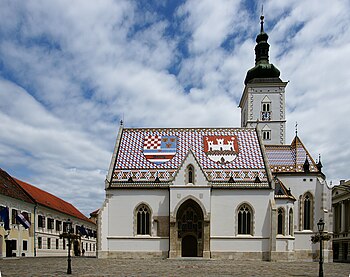St. Mark's Church, Zagreb
This article needs additional citations for verification. (May 2015) |
show This article may be expanded with text translated from the corresponding article in Croatian. (February 2017) Click [show] for important translation instructions. |
| Church of St. Mark (Croatian: Crkva sv. Marka) | |
|---|---|
 | |
 | |
| 45°48′59″N 15°58′26″E / 45.81639°N 15.97389°ECoordinates: 45°48′59″N 15°58′26″E / 45.81639°N 15.97389°E | |
| Location | Zagreb |
| Country | Croatia |
| Denomination | Roman Catholic |
| History | |
| Status | Parish church |
| Events | Radically reconstructed in the second half of the 14th century |
| Architecture | |
| Functional status | Active |
| Style | Late Gothic with some Romanesque features |
| Completed | 13th century |
| Closed | Still Open |
The Church of St. Mark (Croatian: Crkva sv. Marka, pronounced [tsr̩kʋa sʋetoɡ mar̩ka]) is the parish church of old Zagreb, Croatia, located in St. Mark's Square.[1] It is one of the oldest architectural monuments in Zagreb.
Overview[]

The Romanesque window found in its south facade is the best evidence that the church must have been built as early as the 13th century as is also the semicircular ground-plan of St. Mary's chapel (later altered).
In the second half of the 14th century, the church was radically reconstructed.[2] It was then turned into a late Gothic church of the three-nave type.
Massive round columns support heavy ribbed vaults cut in stone and an air of peace and sublimity characterizes the church interior in its simplicity. The most valuable part of St. Mark's Church is its south portal, considered to be the work of sculptors of the Parler family from Prague (end of the 14th century).
The Gothic composition of the portal consists of fifteen effigies placed in eleven shallow niches. On top are the statues of Joseph and Mary with the infant Jesus, and below them one can see St. Mark and the Lion; the Twelve Apostles are placed on both sides of the portal (four wooden statues replaced the original ones which had been destroyed). In its artistic composition and the number of statues, this portal is the richest and the most valuable Gothic portal in southern Central Europe.
Outside, on the northwest wall of the church lies the oldest coat of arms of Zagreb with the year 1499 engraved in it (the original is kept in the Zagreb City Museum).
On the roof, tiles are laid so that they represent the coat of arms of Zagreb (white castle on red background) and Triune Kingdom of Croatia, Slavonia and Dalmatia.[3]
As the corner of St. Mark's Square and the present day Street of Ćiril and Metod, was a Town Hall, the seat of the city administration in medieval times. The building has gone through a number of alteration and reconstruction phases, and today this old Town Hall still keeps its doors open for the meetings of the Zagreb City Council.
Gallery[]


St. Mark's Church from air

Coat of arms of the Triune Kingdom of Croatia, Slavonia, and Dalmatia (left), and the city of Zagreb (right).[3]

Interior

Bell tower of St. Mark's Church in Zagreb.
See also[]
References[]
- ^ "Crkva Sv. Marka". Zagreb Tourist Board. Archived from the original on 20 December 2010. Retrieved 4 August 2014.
- ^ "St Mark's Church". Lonely Planet. Retrieved 4 August 2014.
- ^ Jump up to: a b Damjanovic, Dragan (2011). "Polychrome Roof Tiles and National Style in Nineteenth – Century Croatia". Journal of the Society of Architectural Historians. 70 (4): 466–491. doi:10.1525/jsah.2011.70.4.466.
Further reading[]
- "Skulpture s južnog portala crkve Sv. Marka u Zagrebu: izvješće o konzervatorsko-restauratorskim radovima obavljenim do lipnja 2006" [Sculptures from the south portal of St Mark’s in Zagreb – a report about conservation and restoration treatment carried out by June 2006] (PDF). Informatica Museologica (in Croatian). 39 (1–4): 187–195. September 2009. Retrieved 12 February 2017.
External links[]
| Wikimedia Commons has media related to St. Mark's Church, Zagreb. |
- 13th-century Roman Catholic church buildings in Croatia
- Religious buildings and structures in Zagreb
- Gornji Grad–Medveščak
- Gothic architecture in Croatia





